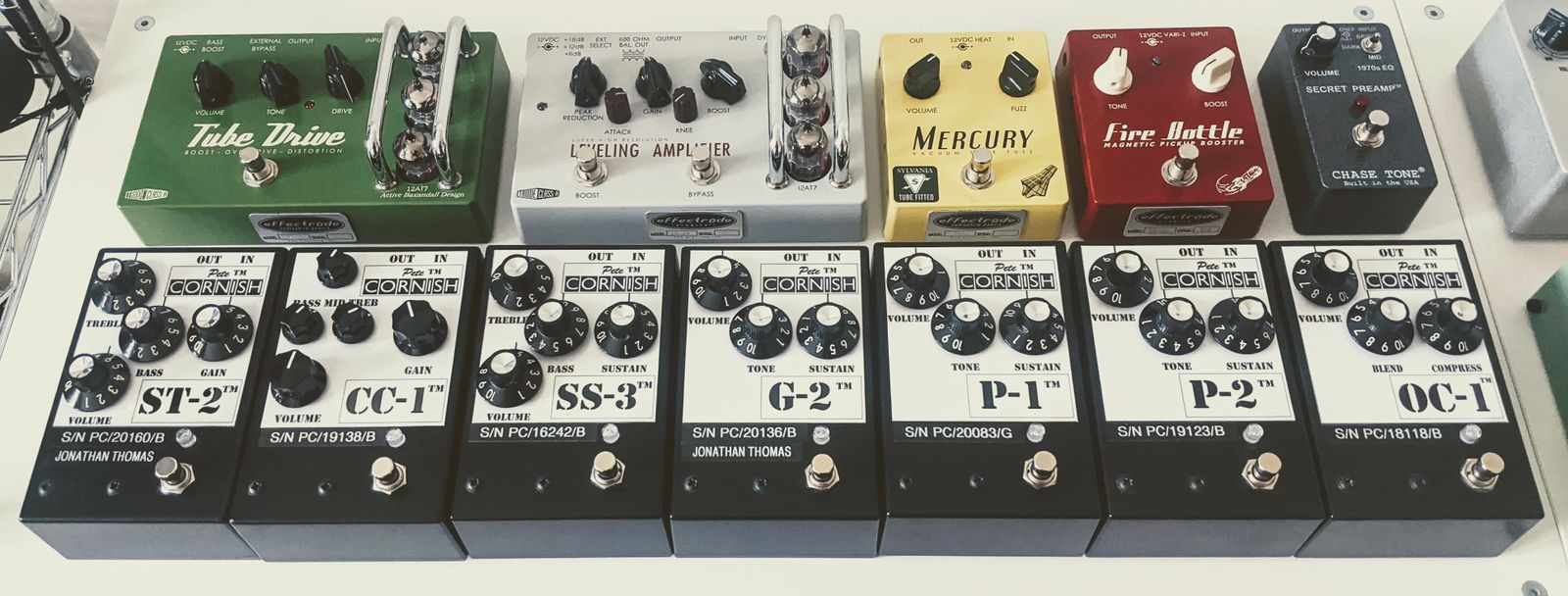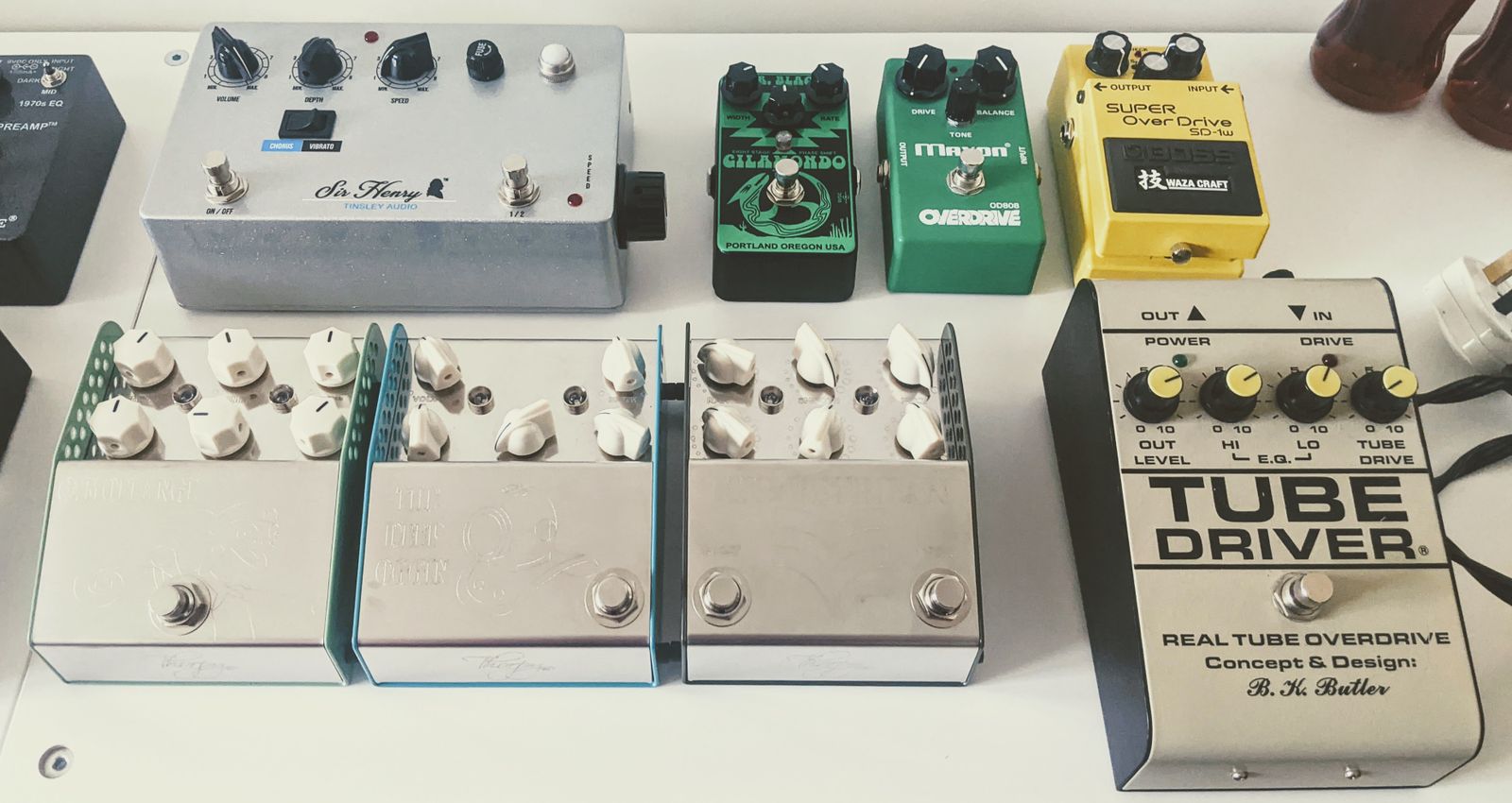It’s April 2020 and much of the world was recently put in lockdown. Attempting to swerve a cripling and unforgiving pandemic that would ultimately go on to cost so many lives and caused tremendous sadness and grief. It still is, to this day.
Many made lifestyle changes, many started hobbies, but for us guitarists, being stuck at home was a good thing in some ways, because it meant we had more time to play and to check out new gear.
During such a tumultuous period in our history, concentrating on building up a gear collection was a form of escapism from boredom of having to isolate away from loved ones. I had visions of grandeur, building the rig of my dreams with amps and pedals I’d always wanted, in order to achieve tones I’d always loved and chased. And so it started.
The pedal bored [sic]

The pedals on the chopping board and ready to be put in the classifieds.
Like many guitarists, I love pedals and there’s something fun about owning different pedals that make unique sounds. I’d built up a steady and respectable collection that would allow me to emulate my favourite guitar tones from records I loved by Queens of the Stone Age, Muse and David Gilmour as well as providing a platform to get some unique tones of my own.
But my perception, back in 2020, was that these were budget pedals, not the “ultimate”, whatever that means. I thought that a new suite of more expensive and boutique pedals would be the way to go. So I put them on sale to try and raise money for some bigger purchases.
The ironic thing is that I look at this picture and I wish I had many of those pedals in my posession right now (in November 2021). Namely the Big Muff reissues, the Retro-Sonic Flanger, the Catalinbread SFT. Maybe even the TD-X and Big Sky. The TD-X is rare as hell, 18 months on, given that Buffalo FX have since gone out of business.
The dream pedal board

An array of Pete Cornish and Effectrode pedals…

…accompanied by a modulation section from Thorpy and Tinsley Audio.
I started exploring pedals I’d always dreamed about.
I’d managed to get a Cornish SS-3 overdrive and OC-1 compressor in 2019, when I first got the Laney Lionheart. It was my aim to gather a large collection of Pete Cornish pedals. I’d owned these before and they’re my favourite of the Cornish line.
Effectrode
My first pedal purchase after selling all of the others, was the Effectrode LA-1A Leveling Amplifier. If you buy high grade pedals, the chances are you might think about pedals with valves/tubes in them. They’re not great for gigging musicians, I presume, but I’m not one, and this was going to be sat in my studio and it sounded incredible. It adds a sheen of high fidelity to your signal that just smooths out your tone beautifully. Was a strange choice to start with, but I’m a sucker for compressors and for Effectrode pedals. I only ever owned their small form PC-2A Compressor and the Fire Bottle up to this point, so I was pleased to try their larger format pedals and I wasn’t disappointed.
As time went on, I decided that I’d revisit the Effectrode Fire Bottle, which brings with it some thickness that the Laney sometimes lacks…think the darker nuances heard in the intro solo for ‘Shine On You Crazy Diamond’. The Laney on its own can sound thin and bright, where the Fire Bottle brings some thickness and weighty bass to a crystal clear clean tone that really helps.
I always really fancied trying a valve driven fuzz pedal, so I was intrigued to try the Effectrode Mercury Fuzz. I don’t know why, but I sold this pedal soon after I bought it, maybe because I didn’t use it as much as I thought I would for the traditional high gain fuzz tones that I’m used to. As with all these things, I immediately missed it in the aftermath and when I realised that it gave me a very nice overdrive tone that I missed. Think the tone of the first solo in Bryan Adams' Everything I Do, which I’ve always really admired. Sort of a nice blend between a clean signal and a overdrive/fuzz, it’s really nice.
Much later in the year, after acquiring a Hi-Tone (more on that later), I needed something that gave me a more crunchy overdrive. Enter the Effectrode Tube Drive. A spectacular sounding drive that delivers everything you’d need from one. I can’t say enough about this pedal. The tone control is superb, a baxandall EQ curve that sounds just right in every position of the knob, quite spectacular. And the amount of gain on tap is perfect for what I was looking for at the time, made the Hi-Tone sing.
Pete Cornish
My love for Cornish pedals comes from the legacy he’s built over decades by building some of the most spectacular sounding, space ship sized rigs that have occupied the stage of many of my favourite artists. David Gilmour in particular.
Where Gilmour’s most recent iteration of live gear (as of 2016) may not have much Cornish, I went in completely the opposite direction, in the hope of perhaps attaining some of the tones I’d enjoyed of David’s days when he had many Cornish units at his disposal.
I managed to save up enough money for Pete Cornish’s ST-2, CC-1, G-2, P1 and P-2 to add to my SS-3 and OC-1. The Laney Lionheart sounded incredible with the ST-2, CC-2 and G-2. The P-2 sounds great with it, too, but the P-1 really needs a Hiwatt style circuit, in my humble opinion. Maybe because the P-1 is a more typical Muff design with scooped mids, something the Laney has too. So the Hiwatt would give the mids a push. The P-2 has plenty of mids and therefore sounded great with the Laney.
Thorpy FX
I’m a big fan of Adrian Thorpe’s work. He’s also been a great help over the years and has given me very helpful advice with regards to how to successfully build my rig. I decided the only route to go down for modulation was his Camoflange and Deep Oggin Chorus, and for those thicker fuzz tones that the Mercury Fuzz wouldn’t give me (for Echoes era Floyd etc), I got one of his highly acclaimed Veteran Silicon Fuzz pedals which has Fuzz Face and Range Master circuits in one neat chassis.
Mixing flanger and chorus with dry signal
I went through some trials to get to the Thorpy modulation conclusion, though. Starting with a Retro Sonic Flanger and later with a very authentic sounding Hartman Flanger. Also getting a 1983 Boss CE-2 modded to kill the dry signal, effectively outputting only the vibrato side of the chorus sound. And attempting to route these pedals through a Lehle Parallel Mixer, to various degrees of success. The flangers didn’t work at all. The CE-2 sounded incredible though! “Just like Gilmour”, or so I told myself!
This lead to two conclusions. Sell the Flangers to afford a Thropy which had a mix control built in and sounded close to the Mistress tones us Gilmour aficionado’s enjoy. And some stupid idea to sell the CE-2 to get a Cornish Super Chorus, because I loved the tone so much. Counter productive a decision if ever there was one. Not least because there is at least a 31 month waiting list for a Cornish Super Chorus!
So after I realised my mistake, I put my name down on the list, at which point Pete literally said “don’t hold your breath” and I decided to buy Thorpy’s Deep Oggin to tide me over. And what a pedal that is, the sound it creates revolves around you and sucks you in to its whirlpool of tonal goodness.
Other pedals of note
The Maxon and SD-1 were used to boost the high gain amps. The Chase Tone Secret Preamp used to sweeten clean tones as it includes a Echoplex style boost circuit. The Tinsley Audio Sir Henry vibe was a luxury, I admit, it’s renowned in the industry and used by professionals as one of the best univibe style pedals around. The Tube Driver…goes without saying, but that’s a whole different blog post.
Pedal inspiration
From a pedal perspective, it looks very Gilmour inspired, which is a shame because I’ve come to believe that over the years that many of these pedals form the basis of my core tone, too. But there’s no denying that a lot of these purchases were a result of wanting to occasionally create a Gilmour’esque sound.

The tower of power - Hi-Tone 50, Mesa Boogie Dual Rectifier and Marshall JCM 800
Amplifiers
I soon learned that the Laney wouldn’t get me the Gilmour tones I sometimes wanted to play. I ordered a Hi-Tone HT 50 DG. A Hiwatt inspired 50watt amplifier with the famous Cornish/Gilmour mod which internally jumps the normal and bright channels.
When it arrived, I was blown away. It was everything I felt I needed in a clean amplifier and went on to sell the Laney. Which I now believe was a mistake.
As guitarists, we get more attached to certain tones than we think we do. When I sold the Laney, I had no remorse and it went without a second glance. But almost 18 months on, much like the pedals above, I miss it and realise that it was very much MY tone.
Again, I was caught out by the lure of wanting to occasionally sound like Gilmour and neglecting my core tone.
The Mesa and Marshall were superb amps, and they too, are very much part of my sound. I never realised how much I’d come to miss them in coming months.
Losing it all
In September 2020, I had a wake up call. Financially, I’d let things slip and I didn’t track how much I was spending on all of this gear. I soon realised that the only way to fix things for my family and I was to sell it all in the hope that one day I’d be able to buy it all back in a more sensible and better planned manner.
By the end of October 2020, I was left with my beloved red Fender Stratocaster, which I couldn’t bring myself to sell, and just a few plugins on my computer.
To say I’d hit rock bottom would be an understatement. I was devastated. I could have saved more gear, I guess, but that would have kept me in debt for longer and that wouldn’t have solved anything.
A lot of what I purchased in 2020 was born out of boredom and a craving for the best and not a lot of it wasn’t necessarily equipment that I needed. So that mindset needed to change. I needed a hard reset.
It was time for a new journey.
